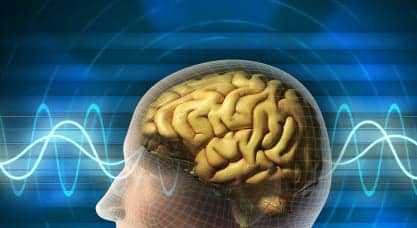Neuroscientists at Georgetown University Medical Center (GUMC) and Germany’s Technische Universität München report that they’ve identified the brain mechanism responsible for tinnitus and chronic pain — the symptoms that can persist long after an initial injury.
In an article slated to appear in the October 2015 issue of Trends in Cognitive Sciences, researchers explain that identifying the underlying problem is the first step to developing effective therapies for tinnitus and chronic pain. In their article, the scientists describe how the neural mechanisms that normally “gate” or control noise and pain signals can become dysfunctional, leading to a chronic perception of these sensations. In their study, the researchers traced the flow of these signals through the brain and showed where “circuit breakers” should be working, but aren’t.
In both disorders, according to the research team, the brain has been reorganized in response to an injury in its sensory apparatus. Tinnitus can occur after the ears are damaged by loud noise or other issue, but even after the brain reorganizes itself, it continues to “hear” a constant hum or drum. Chronic pain can occur from an injury that often is healed elsewhere in the body but persists inside the brain.
“Some people call these phantom sensations, but they are real, produced by a brain that continues to ‘feel’ the initial injury because it cannot down-regulate the sensations enough,” said Josef Rauschecker, PhD, DSc, director of the Laboratory for Integrative Neuroscience and Cognition at GUMC. “Both conditions are extraordinarily common, yet no treatment gets to the root of these disorders.”
The researchers report that areas of the brain responsible for these errant sensations are the nucleus accumbens, the reward and learning center, as well as other brain regions that serve “executive” or administrative roles, such as the ventromedial prefrontal cortex (VNPFC), and the anterior cingulate cortex. All of these areas are also important for evaluating and modulating emotional experiences, according to Rauschecker.
“These areas act as a central gatekeeping system for perceptual sensations, which evaluate the affective meaning of sensory stimuli — whether produced externally or internally — and modulate information flow in the brain. Tinnitus and chronic pain occur when this system is compromised,” Rauschecker says. He notes that other issues often arise in concert with tinnitus and/or chronic pain, such as depression and anxiety, which are also modulated by the nucleus accumbens. Uncontrollable or long-term stress is another important factor in these symptoms.
The brain plasticity that produces some of these changes provides hope that this gatekeeping role can be restored. Because these systems rely on transmission of dopamine and serotonin between neurons, drugs that modulate dopamine may help restore sensory gating.
“Better understanding could also lead to standardized assessment of individuals’ risk to develop chronic tinnitus and chronic pain, which in turn might allow for earlier and more targeted treatment,” said Markus Ploner, MD, PhD, a consultant neurologist and Heisenberg Professor of Human Pain Research at the Technische Universität München (TUM) in Germany.
Rauschecker, an expert in tinnitus, collaborated with Ploner, who studies chronic pain, during his senior fellowship at the Institute of Advanced Study at TUM. Co-authors include Audrey Maudoux, MD, PhD, from GUMC and Elisabeth May, PhD, from TUM.
Source: Newswise; Trends in Cognitive Sciences; Georgetown University Medical Center
For a related story, read this article describing a research study from McGill University Medical Centre that looks at the neuropathic pathways of pain–or, “pain in the brain.”






Are researchers able to identify any relationship with movement, like talking, walking, or body movements that, for me, intensifies the tinnitus? If I am not in motion for longer than 30 minutes the frequency decreases the intensity. It’s been 17 years since my the cochlear implant has saved my life by the way that it allowed outside sounds to relieve tension and distract muscles. I am deaf.
These are very important studies. I hope scientists will be able to achieve a positive result.
Thanks for your article. You can’t even imagine how much easier it became for me after reading it. I was so amazed that you described my husband’s condition. This is unrealistic. My husband suffers from constant squeaking and depression, after reading your article I got the feeling that you were researching his case. I am very glad that now we can count on the fact that this condition can be corrected and he will be able to return to normal life without such sensations. I never thought that his depression could be so closely related to squeaking in her ears. I hope we can handle this.
I have had tinnitus in both ears for 6 months. I’m 42 and had Bell’s palsy of unknown cause at 12 years old. I still have weakness on one side of my face and my right eye moves involuntarily when I move my lips. My face is not symmetrical which I can live with, but the tinnitus is terrible. I had began to experience pain in my extremities and face including the cartilage of my ears. All of my tests have come back negative and I’m not sure what to do next. I have three small children and most of the doctors I have seen attribute my fatigue and pain to being a busy mother. Is there something more I can do or should I try to find a way to live with this? I feel really dejected and worried about how sustainable this is without some hope. Thank you.
almost 2 years no one has been here,i ran across it by mistake,my name is frank i’m retired 73 y.o i have suffered from THE BIG T,FOR 58 YEARS MY WHOLE ENTIRE LIFE has been a huge ball of hurt,anxiety,anger,etc,etc i’m so disgusted hearing we are on the verge of a huge breakthrough there is no new breakthrough all those promises made and seminars telling us more bullshit they[whom ever they are]working on this are really not in a hurry,probably 1 guy working on it, no one gives a shit i remembered telling a doctor my ears ring,his response was ANSWER IT,all i can tell you my fellow RINGERS pray thats all thats left to do
FRANK
There is a clinic in Adelaide Australia that conducts Cold Laser therapy for pain relief and Tinnitus. It is not a cheap process at $7K Australian. Is there any evidence to suggest that Tinnitus is caused by swelling of the brain and that this treatment works?
I have been suffering for 5 years now. Don’t know how it happened, may have been an auto accident or a bad chiropractic adjustment. I pray you will find a cure for this debilitating condition. Thank you
Please keep looking for a cure for Tinnitus. I live in North Central Texas. I have had it in both ears with no stop, only volume, since April 2011. THANK YOU !!!
Thank you for this article and its research. Please keep posting on any advances and treatments.
I am 36 years old and suffer from tinnitus for almost 2 years after heavy metals poisoning with mercury, uranium, tin, strontium, barium. I struggle with a high-pitched sound in both ears 24/7 and it’s hard for me to concentrate and study. My husband told me that he has problems with tinnitus as well, and 6 times more uranium than the acceptable range was a found in his hair as well. I understand from this study that these systems rely on transmission of dopamine and serotonin between neurons. Since mercury, uranium and tin are neurotoxic, I can see why these can potentially give you tinnitus, because they destroy the nerve endings witch contain and release neurotransmitters like serotonin and dopamine. I just hope that after removing the toxins from our bodies and brains, the tinnitus will disappear. For us, tinnitus is just one symptom among many, many others that we have to deal with. Wishing everyone here much health.
HI Nicole, I just read what you wrote on JUly 2, 2016 regarding exposure to mercury, uranium, tin, strontium, barium and having tinnitus. I worked in various laboratories over many years and was exposed to a lot of mercury and lead. Please let me have an update on how you and your husband are now… have you managed to reduce the impact the tinnitus was having on your life? Roger Smith in UK
Dear Nicole,
Please share how you were exposed to such a variety of metals.
I suffer with chronic pain. Instead of Radio Frequency Ablation, which has to be repeated every year or so, why not find a way to sever the nerve completely and then trick it into thinking that this is its real nerve ending, after all actual nerve endings don’t try to keep on growing, generate pain or form a Neuroma?
I have had it (tinnitus) for 3 1/2 yrs now, from a fall, and it is horrible..disrupts everything and headaches are constant…so many frequencies running through my head, I can’t handle it.
I knew two brothers who both suffered from this disorder. Both of them were so distraught they ended their lives.
I’ve had Tinnitus since age 5 or 6. At that time, I told the doctors I had “soldiers,” but nobody took notice. I’m 64 now, and have averaged 2-3 operations a year since birth. I was born deaf in L ear, profound HL in R ear. I also had an abscess on the brain when I was 19, and the tinnitus hasn’t left me alone. I’m now totally Deaf and my tinnitus is giving me severe headaches, as it’s so LOUD. I’m close to saying I can’t take anymore. I’m 64 now, I don’t need this. I’ve been in hospitals so much it’s unbelievable. I would volunteer for tests anytime, anywhere if I can get there. I get a couple hrs sleep, then I struggle through the day. My “soldiers” is now a BIG Hisssss and in R ear it changes so much. I had failed a cochlear implant as well.
CJ
Hello CJ, We are so sorry to hear of your suffering with tinnitus. It sounds like you’ve been dealing with these symptoms for such a long time, and you and many of our other readers must be frustrated to hear of research studies like this one that show important progress, but have not yet reached the stage of clinical trials or treatments on the market. We’ll do our best to continue providing updates on research and clinical trials, as well as available resources (please see HR Editor Karl Strom’s list of resources in an earlier comment), and tinnitus treatments that come to market.
I have had tinnitus for about twenty years , I suffered whiplash after a car accident , I had a lot of trouble with my neck and ear on my left side. I had hearing tests and various medication and nothing helps I have learned to live with it now, but would love it if the noise was not in my ear.
You definitely have to try Upper Cervical Chiropractic treatment. I have heard that they have had great success treating tinnitus due to whiplash and other neck injuries. God bless.
After treatment for an acoustic neuroma with low grade radiation, my tinnitus has been constant. It was there before, but not constant. Hearing was completely gone before treatment.
I’ve been suffering from tinnitus for almost two years. No cause has been found yet. I can’t stand it for so long. If I could be your guinea pig for any kind of treatment. Thanks for your attention.
Wow, my tinnitus started after suffering from chronic pelvic pain syndrome, my pain comes and goes now after successful treatment but the tinnitus has been with me 24/7 for the last two years. I find your research enlightening and has answered for me as to why I have chronic tinnitus. Here’s hoping for a cure.
I have tinnitus in both ears and it is very annoying. I worked around tanks and other loud noises in the military. The bad part is that living in AZ I do not hear rattle snakes. I would like to hear normal sounds with out the other noise. I would like to try something new if it works.
Gives us all hope before life is gone that someone in this world will find a cure. That person/s will be a billionaire. Good luck to all of them, and I hope there will be a trial in Europe. I am in Ireland…Guys, millions are hoping a cure will be found for tinnitus…
I am 66 years old and have had tinnitus for as long as I can remember 24/7. I was told years ago it was due to chronic childhood ear infections and mastoiditis. When I reached my early 50s, it became more noticeable. I believe my previously enlarged mastoid bones have shrunk. This occurred at the same time I began developing osteoporosis. I figure weakening of bones caused the enlarged mastoid bones to basically start collapsing.
I have had very loud and continuous high pitched ringing in my ears for over 50 years. It is more prominent in the left ear. If I could be a part of a human study to help find a cure I am available anytime as I am retired. I would just love to have this tone down to a more manageable level. Please say you are doing human trials in the USA.
This research has not yet reached the human trial phase, but when it does, a US-based clinical trial would most likely be administered by/at Georgetown University Medical Center (GUMC) in Washington, DC, where the preliminary research is taking place under the direction of Professor Josef Rauschecker. Here is the link to GUMC: https://gumc.georgetown.edu/
Hello I read that another viewer had Bells Palsy and thought that maybe the tinnitus was a result of or made worse by this condition. I too had Bells palsy and since my tinnitus has been getting worse. I would jump at the opportunity to be part of a study that could possibly find a cure or a maintenance program for this affliction
While this research is exciting, if you’re having persistent bothersome tinnitus, it’s probable that your best bet is to seek help from an audiologist or licensed professional who has specialized training in tinnitus treatment. From some of the research that we’ve reported about, it’s quite possible that tinnitus could have several origins/etiologies (ie, not just the “phantom pain” aspect) and can even signal an “ear in distress” warranting a trip to a medical doctor. As mentioned in some of the comments below, there are a number of treatment options including hearing aids and (in extreme cases) cochlear implants. For a summary, see the recently published AAO-HNS guidelines at: https://hearingreview.com/2014/10/first-ever-clinical-practice-guideline-tinnitus-published-aao-hnsf and click on the links. The American Tinnitus Association (http://www.ata.org) also has some very good resources and starting points. For those in the US, the Tinnitus Practitioners of America provides a membership directory at http://www.tinnituspractitioners.com/find_a_practioner.aspx . Finally, Audiologist Douglas Beck, PhD, wrote an article that summarizes recent tinnitus literature and treatment philosophies at: https://hearingreview.com/2014/09/issues-tinnitus-2014-2015 .
Have researchers identified any correlation with vibration such as walking, talking, body movement which for me intensifies the tinnitus? If motionless for 30 minutes or more, it typically decreases in intensity. Going on 17 years and cochlear implant saved my life in bringing outside sounds to both distract and ease tension in muscles. I am deaf.
I’m not aware of anything that we have published that specifically addresses this issue, but it certainly exists and could include what is referred to as “somatically modulated tinnitus.” A well-known audiologist and educator, Jay McSpaden, PhD, covered some of the different aspects of tinnitus for hearing professionals in a now-slightly-dated article that you may find interesting: https://hearingreview.com/2007/08/a-brief-overview-of-tinnitus-for-dispensing-professionals/
Hi, i´m from Brazil, and i suffer from tinnitus for 26 long years due to a reparatory surgery in the eardrum and put myself at the disposal as a guinea pig for research …
I wish to put myself forward as a guinea pig for any treatments that could rid me of the nerve damage, chronic pain and crucifying tinnitus that I have suffered for 15 years due to an operation for Syringa Myaela. Thank You
These studies are still in the early/preliminary laboratory stages, Marjorie, but check our website in future for any updates on when these studies might advance to clinical trials. We hope for your sake, and for others who suffer from debilitating tinnitus, that research progresses quickly. Thanks for being part of the conversation!
I’ve had tinnitus for 40 years, I was 28 years old and just recovered from Bells palsy. It has definitely got louder as the years have progressed, worse at night, and recently it changed pitch for 4 days and was louder and hollow. English doctors cannot treat this condition. I was sent for a hearing test and my hearing was good.